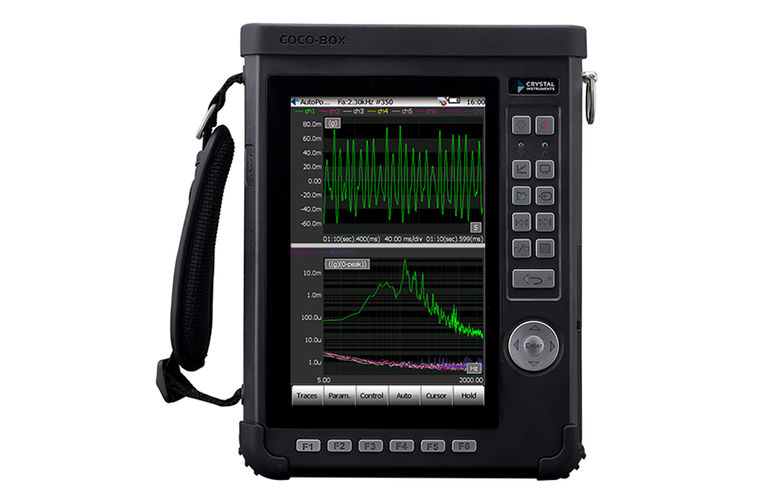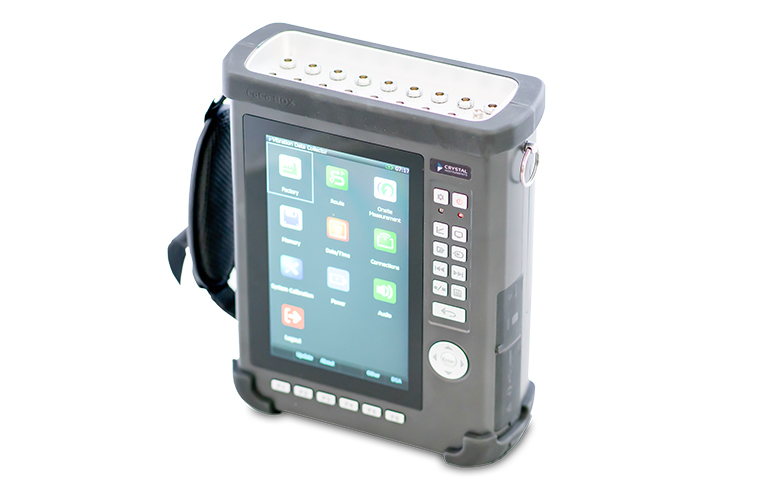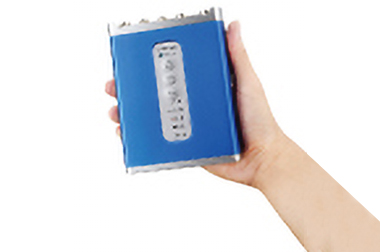Main Menu
- Home
- Product Finder
- Calibration Systems
- Calibration Services
- Digital Sensing
- Industrial Vibration Calibration
- Modal and Vibration Testing
- Non-Destructive Testing
- Sound & Vibration Rental Program
- Learn
- About Us
- Contact Us
 Crystal Instruments' dynamic signal analyzers provide users with the flexibility to create a dynamic signal analysis solution according to their needs. Options for portability, remote monitoring, and pre-loaded operations are all possible with Crystal
Instruments’ DSA solutions.
Crystal Instruments' dynamic signal analyzers provide users with the flexibility to create a dynamic signal analysis solution according to their needs. Options for portability, remote monitoring, and pre-loaded operations are all possible with Crystal
Instruments’ DSA solutions.
A full manual set as well as start up application notes and videos are available. Additionally, an Application Engineer will contact you at the start of each rental to ensure that installation and setup / testing parameters are fully understood.
Crystal Instruments' Engineering Data Management (EDM) software is included with each system. EDM is designed for real-time data management and processing. This easy to use, Windows-native software manages the communication between your PC and all Crystal Instruments hardware platforms.
In post processing mode, EDM lets users browse through data files and quickly import the data content and attributes of each channel. Time traces are played back. Cursors and zoom features let you view the signal property details. EDM post processing includes data conditioning, real-time filters, FFT spectral analysis, curve-fit, THD, RMS calculation, octave filters, order tracking, trending, and alarms. Displays include time and spectra, waterfall, color-map spectrogram, and bode plots. After post processing, data can be exported or used to generate reports.

The CoCo-80X Dynamic Signal Analyzer features a 7-inch LCD touchscreen, 2, 4, or 8 input channels, long battery life, and optional WiFi and GPS. The CoCo hardware platform supports two different software working modes: Dynamic Signal Analyzer (DSA) and Vibration Data Collector (VDC). Each working mode has its own user interface and navigation structure. DSA mode is designed for mechanical structure analysis, testing and optimization, electrical, geophysics, and a wide range of other applications. VDC mode is dedicated to route-based machine condition monitoring, vibration data collection, and trending.
Analysis Features
Hardware Features

The CoCo-90X Dynamic Signal Analyzer features a 7-inch LCD touchscreen, 16 input channels, long battery life, and optional WiFi and GPS. The CoCo hardware platform supports two different software working modes: Dynamic Signal Analyzer (DSA) and Vibration Data Collector (VDC). Each working mode has its own user interface and navigation structure. DSA mode is designed for mechanical structure analysis, testing and optimization, electrical, geophysics, and a wide range of other applications. VDC mode is dedicated to route-based machine condition monitoring, vibration data collection, and trending.
Analysis Features
Hardware Features

A compact yet powerful dynamic signal analyzer and data recorder with built-in WiFi. It provides up to four 24-bit input channels and a unique software-selectable tachometer-input/signal-source output channel. It is PC-independent and features a 6-hour battery life in full operating mode.
Analysis Features
Hardware Features

Spider-80X scales from 8 to 512 channels and is ideal for dynamic data acquisition, vibration control, and machine monitoring. Spider-80Xi is a compact version of Spider-80X with an extremely lightweight form factor.
Analysis Features
Hardware Features

EDM Modal is a complete Modal Testing and Modal Analysis suite for Experimental Modal Analysis (EMA). With its intuitive controls and powerful features, EDM Modal is the ultimate tool for modal analysis applications. An intuitive interface allows users to manage highly complicated tests that can involve hundreds of measurement points and multiple excitations. This interface also allows for simple tests to be conducted quickly and with little effort. Regardless of how complicated the modal test is, EDM Modal provides exactly the right tools to achieve your goal.
To successfully acquire testing data, it is essential to properly book-keep the Degrees-of-Freedom (DOFs) of the test structure. The Geometry Editor handles all types of structure modeling and supports all types of coordinate systems. Using the concept of ‘components,’ parts of a complicated structure can be built simply and then integrated into the geometric model. Inside the Input Channel Setup window, the measurement points and their corresponding directions can be defined. Once the test is started, the measurements will proceed through all the test points, as defined by the Degree of Freedom (DOF) information for each measurement point.
Modal Parameter Identification Including Several Curve Fitting Methods
EDM Modal Includes